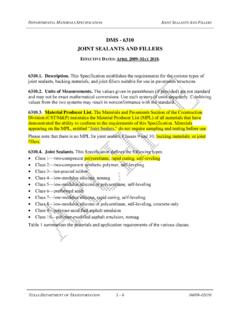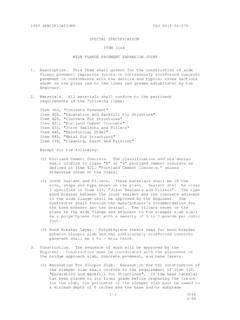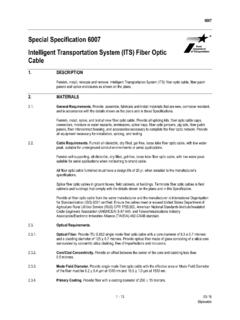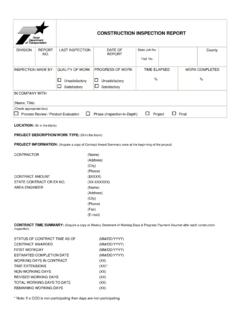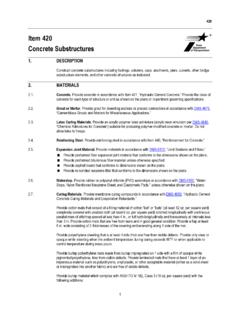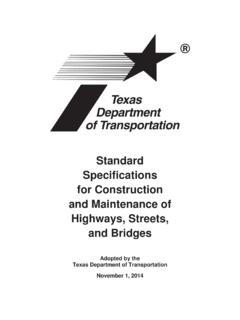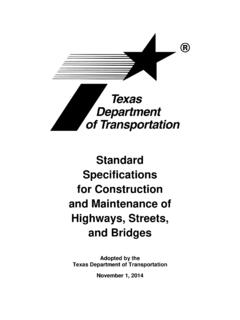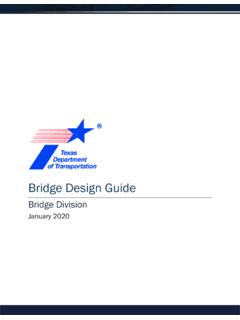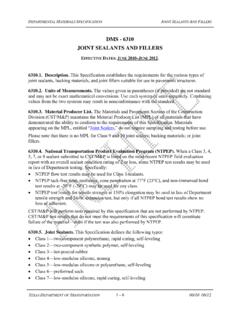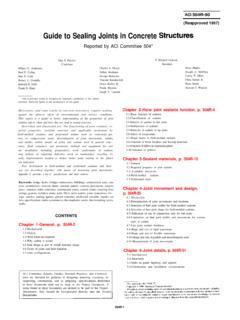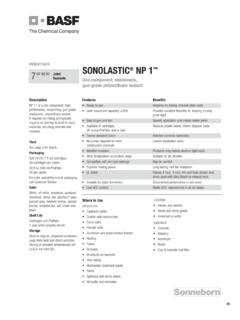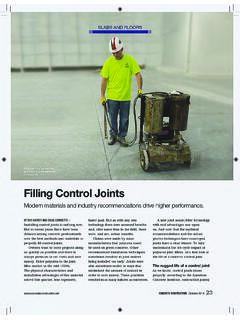Transcription of ITEM 360 CONCRETE PAVEMENT - ftp.txdot.gov
1 ITEM 360 CONCRETE PAVEMENT Description. This Item shall govern for the construction of portland cement CONCRETE PAVEMENT with or without monolithic curbs on a prepared subgrade or subbase course, in accordance with the typical sections shown on the plans, the lines and grades established by the Engineer and the requirements herein. Paving Construction Plan. The Contractor shall submit a paving construction plan for approval by the Engineer prior to beginning PAVEMENT construction operations. The plan shall contain the mix design, methods of construction, description of equipment to be used in mixing, placing, finishing, curing, lighting and miscellaneous materials, and early usage of CONCRETE PAVEMENT . The plan also shall include location, sequence, and construction methods for leaveouts which are shown on the plans or due to the Contractor's operations.
2 Revision to the paving construction plan may be requested by either party and the revision shall be submitted to the Engineer for approval. Materials. Unless otherwise shown on the plans or required herein, all materials shall conform to the requirements of the pertinent Items as follows: Item 300, "Asphalts, Oils and Emulsions" Item 420, " CONCRETE Structures" Item 421, "Portland Cement CONCRETE " Item 433, " joint Sealants and fillers " Item 437, " CONCRETE Admixtures" Item 440, "Reinforcing Steel" Item 526, "Membrane Curing" except for the following: (1) Portland Cement CONCRETE . Classification and mix design shall conform to Class "P" portland cement CONCRETE as defined in Item 421, "Portland Cement CONCRETE ", unless otherwise shown on the plans. The Contractor shall obtain written permission from the Engineer prior to the use of Type III cement when Type III cement is not shown on the plans.
3 (2) joint Sealants and fillers . These materials shall be of the size, shape and type shown on the plans. Unless otherwise shown on the plans, the joint sealant materials to be used shall conform to the requirements of Class 5 joint sealant as described in Item 433, " joint Sealants and fillers ". (3) Dowels for Expansion and Contraction Joints. Dowels shall be smooth, straight steel dowels of the size and type shown on the plans and shall conform to the requirements of ASTM A 615, Grade 400. The free end of dowels shall be smooth and free of burrs. Unless otherwise shown on the plans, the entire length of each dowel shall be coated with a hot applied asphalt cement. Cut-back asphalts and emulsions shall not be used. Unless otherwise shown on the plans, the asphalt coated end of each dowel to be used in an expansion joint shall be encased in an approved cap having an inside diameter of two (2) millimeters greater than the diameter of the dowel.
4 The cap shall be of such strength, durability and design as to provide free movement of the dowels and shall be approved by the Engineer prior to use. The end of the cap shall be filled with a soft compressible material or shall be void in order to permit free movement of the dowel for a distance equivalent to 150 percent of the width of the joint used. The dowel caps and dowels shall be held securely in place by ties as shown on the plans, or as approved by the Engineer. (4) Positioning and Support Devices for Reinforcement and joint Assemblies. These devices shall be of sufficient structural quality to prevent movement of the dowels or steel reinforcement during CONCRETE placement and finishing. Devices shall be of a type approved by the Engineer. Positioning and supporting devices (chairs) for steel reinforcement bars shall be either plastic or metal and of sufficient number to maintain the position of the bars within the allowable tolerances.
5 Metal positioning and supporting devices for expansion and contraction joint assemblies (such as welded wire bar chairs, bar stakes, etc.) where used shall be as shown on the plans or may be similar devices of equivalent or greater strength, approved by the Engineer. The support devices shall secure the joint assembly and dowels within the allowable tolerances while providing no restraint against joint movement. Dowels used in joint assemblies shall be secured in parallel position by a transverse metal brace of the type and design shown on the plans, or may be secured by other devices approved by the Engineer. The devices shall provide positive mechanical connection between the brace and each unit (other than by wire tie) and prevent transverse movement of each load transmission device. (5) Reinforcing Steel.
6 ASTM A 616 Grade 400 will be permitted for straight bars only. Reinforcing steel that requires bending shall be ASTM A 615 Grade 300 with the spacing reduced to 2/3 of that shown for Grade 400 reinforcing steel. When shown on the plans, corrosion protection shall be applied to dowels and tiebars. (a) Tie Bars. Tie bars at weakened plane longitudinal joints shall be straight reinforcing bars. Tie bars at longitudinal construction joints shall be either multiple piece tie bars or straight reinforcing bars, when equipment or conditions permit. Bent reinforcing bars may be used for longitudinal construction joints unless otherwise shown on the plans. (b) Multiple Piece Tie Bars. Multiple piece tie bars (threaded coupling or other adequate devices) shall develop a tensile strength over their entire length equal to 1 1/4 times the yield strength of the tie bars shown.
7 Each end of multiple piece tie bars shall consist of deformed reinforcement of at least the size shown on the plans, conforming to Item 440, "Reinforcing Steel". The deformed portion of each end of multiple piece tie bars shall be at least 1/2 of the length of the tie bars shown on the plans. Unless otherwise shown on the plans, the spacing for multiple piece tie bars shall be equal to or less than that of the transverse bars shown. (6) Curing Materials. Curing material shall conform to Type 2 Class A curing compound or emulsified asphalt of the type and grade as shown on the plans. Equipment. (1) General. All equipment shall be maintained in good condition and approved by the Engineer before the Contractor will be permitted to begin construction of the PAVEMENT . (2) Weighing and Measuring Equipment. Scales, bins and meters shall conform to the requirements of Item 520, "Weighing and Measuring Equipment".
8 (3) Mixer. The mixer furnished shall conform to the requirements of Item 522, "Portland Cement CONCRETE Plants", and shall be either a paving mixer (operated at the construction site or centrally located), stationary mixer (central mixer), or truck mounted paving mixer. A transit mixer, conforming to Item 522, "Portland Cement CONCRETE Plants", may be used for mixing CONCRETE for PAVEMENT only when permitted on the plans. A transit mixer will be allowed for curbs, irregular sections and/or small placements such as turn outs and leave outs. (4) Hauling Equipment. Hauling equipment shall conform to one (1) of the following: (a) Wet Batch (Central Mixed) Hauling Equipment. When a central mixer is used, CONCRETE shall be transported to the point of delivery in either agitator trucks or nonagitating trucks. The hauling equipment shall be capable of delivering the CONCRETE to the work site in a thoroughly mixed and uniform mass and discharging the CONCRETE at a satisfactory controlled rate without segregation.
9 (i) Agitator Trucks. Agitator trucks shall conform to one (1) of the following types: (1) Alternate agitating hauling equipment approved by the Engineer in writing. (2) Horizontal axis, revolving drum. (3) Inclined axis, revolving drum. (4) Open top, revolving blade or paddle. The drum, revolving blades or paddles shall be actuated by an engine mounted as an integral part of the unit. When the truck agitator is equipped with a transmission that will govern the speed of the drum or revolving blades or paddles within the specified rpm, no separate engine for rotating the drum will be required. The engine or engine/transmission combination shall be in satisfactory working condition and capable of accurately controlling the agitation speed of the unit. Agitator trucks shall be equipped with facilities to readily permit access for inspection, cleaning and repair of blades or paddles.
10 Each agitator truck shall have attached, in a prominent place, a metal plate or plates on which are plainly marked the various uses for which the unit is designed. The data shall include the manufacturer's recommended agitating speed of the rotating element and the capacity of the unit. If a truck mounted paving mixer is used, the mixer may transport the CONCRETE only after mixing is complete. (ii) Non Agitator Trucks. Non agitator trucks shall have a smooth, mortar-tight, metal bed. (5) Grade Control Equipment. When CONCRETE PAVEMENT is not formed, equipment used in the spreading and finishing of CONCRETE PAVEMENT shall be designed to be operated on a prepared track grade controlled by electronic sensor systems. The systems used on a prepared track grade shall operate from an adequately supported string line or equivalent system approved by the Engineer.
